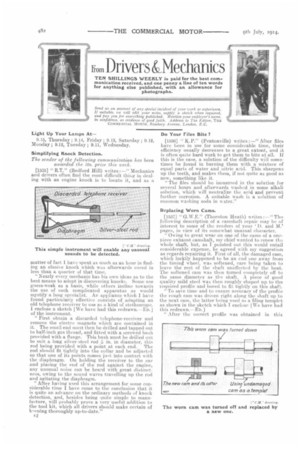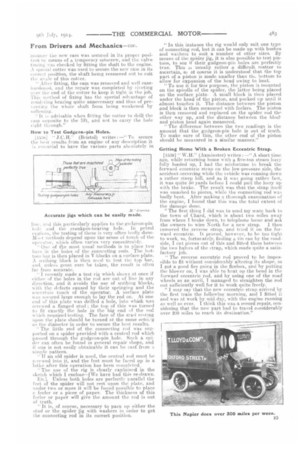Nom Drivers& Mechanics TEN SHILLINGS WEEKLY is paid for the
Page 24

Page 25

If you've noticed an error in this article please click here to report it so we can fix it.
best communication received, and one penny a line of ten words for anything else published, with an allowance for photographs.
Send us an account of any special incident of your work or experience. If suitable, we will edit your notes, supply a sketch when required,
and pay you for everything Published. Mention your employer's name, :r.atMeNerrjr-MS in confidence, as evidence of good faith. Address to The Editor, TIIE COMMERCIAL MOTOR, Rosebery Avenue, London, E.C.
Light Up Your Lamps At 9. 15, Thursday ; 9.14, Friday ; 9.13, Saturday ; 9.12, Monday ; 9.12, Tuesday ; 9.11, Wednesday.
Simplifying Knock Detection.
The sender of the following communication has been awarded the 10s. prize this week.
[1535] "...T." (Bedford Hill) writes ,_Cr Mechanics and drivers often find the most difficult thing in dealing with an engine knock is to locate it, and as a matter of fact I have spent as much as an hour in finding an elusive knock which was afterwards cured in less than a quarter of that time.
"Nearly every mechanic has his own ideas as to the best means to adopt in discovering knocks. Some use guess-work as a basis, while others incline towards the use of such complicated apparatus as would mystify a lung specialist. An appliance which I have found particularly effective consists of adapting an old telephone receiver to use as a kind of stethoscope. I enclose a sketch [We have had this redrawn.—En.j of the instrument.
" First obtain a discarded telephone-receiver and remove the electro magnets which are contained in it. The small end must then be drilled and tapped out to half-inch gas thread, and fitted with a screwed bush provided with a flange. This bush must be drilled out to suit a long silver-steel rod 1'6 in. in diameter, this rod being provided with a point at each end_ The rod should fit tightly into the collar and be adjusted .so that one of its points comes just into contact with the diaphragm. On holding the receiver to the ear .and placing the end of the rod against the engine, any unusual noise can be heard with great distinctness, owing to the sound waves travelling up the rod and agitating the diaphragm.
"After having used this arrangement for some considerable time I have come to the conclusion that it is quite an advance on the ordinary methods of knock detection, and, besides being quite simple to manufacture, will probably prove a very useful addition to the tool kit, which all drivers should make certain of 'keeping thoroughly up-to-date."
E2 Do Your Files Bite ?
[1530] " K.P." (Pentonville) writes :—" After files have been in use for some considerable time, their efficiency usually decreases to a great extent, and it is often quite hard work to get them to bite at all. If this is the case, a solution of the difficulty will sometimes be found in burning them with a mixture of equal parts of water and nitric acid. This sharpens up the teeth, and makes them, if not quite as good as new, something like it. "The files should be immersed in the solution for several hours and afterwards washed in some alkali solution, which will neutralize the acid and prevent further corrosion_ A suitable wash is a solution of common washing soda in water."
Replacing Worn Cams.
[1537 " G.W.E." (Thornton Heath) writes :--" The following description of a camshaft repair may be of interest to some of the readers of your 'U. and M.' pages, in view of its somewhat unusual character.
"Owing to great wear on one of the cams of a onepiece exhaust camshaft, my chief wanted to renew the whole shaft, but, as I pointed out t his would entail considerable expense, he agreed with my suggestion as regards repairing it. First of all, the damaged earn, which luckily happened to be an end one away from the timing wheel, was softened, care being taken to leave the rest of the shaft unaffected by the heat. The softened cam was then turned completely off to the same diameter as the shaft. A piece of good quality mild steel was then roughly shaped up to the required profile and bored to fit tightly on this shaft.
"To save time and to ensure accuracy of the profile the rough cam was driven right along the shaft up to the next cam, the latter being used as a filing templet as shown in the sketch which I enclose [We have had this redrawn.---En.]
" After the correct profile was obtained in this manner tiie new earn was secured in its propel posit ion in means of a, temporary setscrew, and the valve timing 'Yes checked by fitting the shaft to the engine. .1 special cotter was used to secure the new cam in its cured t position, the shaft beiug reamered out to suit the anale of this cotter.
" After fitting, the cain was removed and well casehardened, and the repair was completed by tiveting over the end of the cotter to keep it tight in the job. This method of fixing has the special advantage of rendering brazing quite unnecessary and thus of preventieg the whole shaft from being weakened by softening.
It is advisable when fitting the cotter to drill the cam opposite to the lift, and not to carry the hole r i ght th rough."
How to Test Gudgeon-pin Holes.
115:i8] " J.C.H." (Bristol) writes :—" To secure the best results from an engine of any description it is essential to have the various parts absolutely in line. and this particularly applies to the gudgeon-pin holt, And the crankpin-bearing bole. In petrol eligii.es, the testing of these is very often badly done. Most methods depend upon the sense of touch of the operator, which often varies very considerably. One of fbe most usual methods is to plate two bars in the holes of the co/meeting rods. The la-attom liar is then placed in 1T-blocks on a surface plate. A scribing block is then used to test the top bar, and, unless great care be taken, the result is often far from accurate.
" I recently made a test rig which shoes at once if either of the holes in the rod are out of line in any direction, and it avoids the use of scribing blocks, milli the defects caused by their springing and the uncertain touch of the operator. A surface plate
as secured large enough to lay the rod on. At one end of this plate was drilled a hole, into which WF1S screwed a flanged stud ; the top of this was turned to fit exactly the hole in the big end or the rod which required testing. The face of the stud resting upon the plate should be turned at the same ectireg as the diameter in order to secure the best results.
" The little end of the connecting rod was supported on a spider provided with a central rod which passed through the gudgeon-pin hole. Such a spidec can often be found in general repair shops, and if ime is not easily obtainable it can be east frem a simple pattern. " if an old spider is used, the central rod must be screwed into it, and the feet must be faced up in a lathe after this operation has been completed.
"The use of the rig is clearly explained. in the sketch which I enclose—rWe have had this; re-drawn.
lin.l. Unless both holes are perfectly parallel the feet of the spider will not rest upon the plate, and under two or more it will be found possible to place e feeler or a piece of paper. The thickness of this feeler or paper will give the amount the rod is out of truth.
" It is, of course, necessary to pack up either the stud or the spider tig with washers in order to get the connecting rod in its correct position. "In this instance the rig would only suit one type of connecting rod, but it can be made up with bushes and wathers to suit. a number of other sizes. By means of the spider jig, it is also possible to, test pistons, to see if their .gudgeon-pin holes are perfectly true. This is usually rather a difficult matter to ascertain, as ot course it is understood that the top part of a piston is made smaller than th, bottom to allow for expansion of the head owing to heat. " To use it for this purpose, the piston is mounted on the spindle of the spider, the latter being placed on the surface plate. A small block is then placed under the head of the piston, and packed up until it almost touches it. The distance between the piston and block is then measured with feelers. The piston is then removed and replaced on the spider rod the other way up, and the distance between the block and piston head again measured. "The difference between the two readings is the amount that the gudgeon-pin hole is out of truth. To make sure of this, the other end of the piston should be measured in a similar manner."
Getting Home With a Broken Eccentric Strap.
L1539.1 W, H." (Axminster) writes :—" A short time ago, while returning home with a five-ton steam lorty fully loaded up, I had the misfortune to break the forward eccentric strap on the low-pressure side, the accident occurring while the vehicle was running down a rather steep hill, and as it was going rather fast, it was quite 50 yards before I could pull the lorry up with the brake. The result was that the strap itself was smashed to pieces, while the connecting rod was badly bent. After making a thorough examination of the engine, I found that this was the total extent of the damage done.
" The first thing I did was to send my mate back to the town of Chard, which is about two miles away from where T broke down, to telephone home and ask the owners to wire North for a new strap. I then removed the reverse strap, and tried it on the forward eccentric. It proved, however, to be toe tight to work, so, fortunately, finding a Lin can by the roadside, I cut pieces out of this and fitted them between the two halves of the strap, which made quite a satis• factory job.
" The reverse eccentric rod proved to be impossible to fit without considerably altering its shape, so I got a good fire going in the firebox, and by putting the blower on, I was able to heat up the bend in the forward eccentric rod, and by using one of the road wheels as an anvil, I managed to straighten the rod out sufficiently well for it to work quite freely.
" I may say that the new eccentric strap arrived by the first train the following morning, and I fitted it and was at work by mid-day, with the engine running as well as ever. I think this was a record repair, considering that the new part had to travel considerably over 200 miles to reach its destination."


























